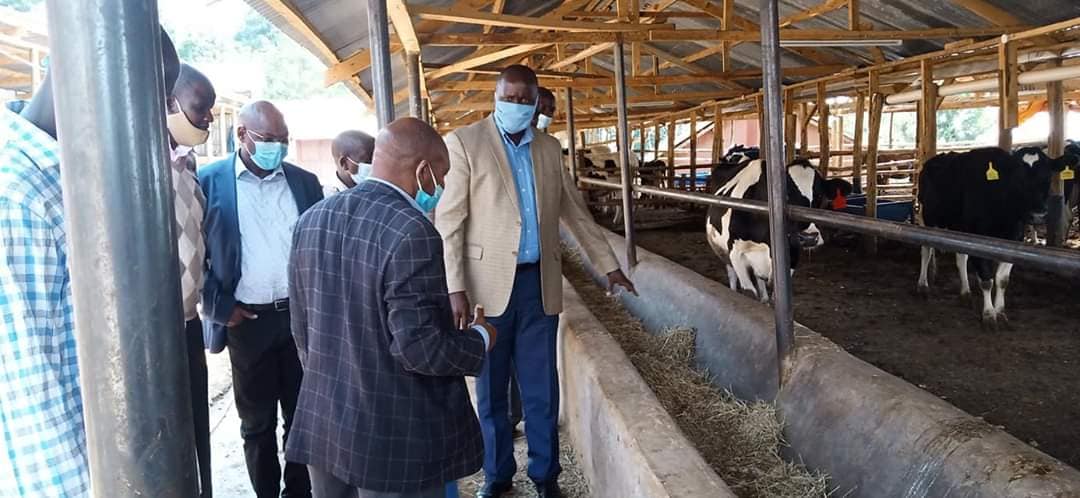 Government officials at Peter Chirchir's farm
Government officials at Peter Chirchir's farm
By George Munene
After switching from open field to zero-grazing, in four short years, Peter Chirchir has built a benchmark farm housing around 50 cows. His milking herd consists of 24 cows averaging 25 litres between them. Milking 520 litres daily, he sells his milk directly to consumers at between Sh50-60 per litre.
The resident of Kapsoit ward, Kericho County, says he’s always been passionate about animal husbandry. In 2017, he had seven free-ranged cattle and was milking 30 litres from four of them. Although he’d always been accumulating a knowledge base on dairy farming and had planned on venturing into intensive dairy farming, it was not until a benchmarking trip to Kericho that he got a first-hand account of and learnt the ropes on zero-grazing.
Since then he has steadily improved and increased his heard, sourcing and buying cows from Iten, Eldoret to Githunguri, where he bought his best producer which milked 35 litres but with proper feeding and treatment, now gives him 44 litres.
Chirchir has become a leading light for medium scale holder dairy farmers in his region, even recently hosting visitors from the national and county government led by livestock principal secretary Harry Kimutai, on a fact-finding mission on problems facing Kenyan dairy farmers. He also hosts other farmers looking to improve their husbandry skills on his farm every weekend.
“With zero-grazing, there is minimal wastage as cows are confined, using most of the energy gotten from feeds for growth and milk production. My entire zero-grazing unit sits on less than ¼ an acre and this gives me the opportunity to grow high yielding and high-value fodder on the rest of my land,” he adds.
For feeding, Peter grows maize on his own three acres, ¼ acre of napier grass, and has leased another 10 acres for growing boma rhodes grass for hay. He grows the Dk 777 maize variety, harvesting at 2 ½-3 months when the maize corn is milky as at this stage the starch content and fibre digestibility is at an optimum range. He is able to harvest four loads of silage maize annually, enough to feed his heard for the year. For harvest and compacting, he hires a forage harvester from the county government at a cost of Sh1800 per hour. In making his silage he does not use any molasses as the maize’s cob and stalk have enough sugars that allow for fermentation. Peter prefers surface to pit silaging—from his experience, it is harder to prevent water sipping into and rotting silage stored in trenches. When the price of hay falls, he buys more bales to bolster his reserves—he recently bought 1000 bales for Sh60 each.
Related News: 37.5 million project to help women dairy farmers improve production and access markets
Related News: Farmers’ Friend: Behavioural traits to avoid in dairy cattle
For his milkers, Peter feeds them on a ration of silage, hay and dairy meal. The quantity of dairy meal he gives is calculated by one kilogram dairy meal for every two litres of milk a cow gives above the first five litres. For heifers, he opts for napier, hay, standard maize germ and wheat straw as well as about three kilos of dairy meal as they reach their first calving. For his calves, he separates them from their mother on the second day after their birth and feeds them on six litres of milk for their first month, four litres for the second and two litres for the third month. On the fourth month, he feeds them on one litre of milk for the first week and begins to wean them on the second.
For milking purposes, he uses a fixed Delaval milking system capable of milking four cows in one go, having ditched portable cow milking machines. This he says has greatly reduced the usual time spent on milking by his five farmhands. He also eschews the use of cow mattresses—a fixture in most modern Kenyan dairy units. Having used them until two years ago, he now prefers to have his cows’ bed in straws and dung as he has found them to be more comfortable and less prone to mastitis. Mattress he says, are also expensive and demand the farmer uses a lot of water washing them.
He serves first-time calvers with sexed semen and conventional semen to second and third-time calvers as fertilisation rates of sexed semen in repeat mothers is often low. He recommends farmers master the AM to PM rule—serving 12 hours at the onset of heat as this avoids conception failure.
Apart from occasional flare-ups of mastitis and milk fever, instances of diseases in his herd are negligible. This is because his cows are fenced in and stall-fed having no interaction with other cows that might be disease carriers. Cows gotten colder parts of the country easily adapt to warmer climates he says, though he also gives climate adaptation injection to help new cows easily grow accustomed to their new environment.
Related News: Dairy farmer shares lessons learnt after recovering from near shut-down
Having been amongst the many farmers who lost their money after Kenya Co-operative Creameries collapsed in 1999, Peter has always been intent on owning the entire agricultural value chain—from his farm to the final consumer. At Kapsoit town, he has his own shop which he pays Sh5,000 in monthly rent from where he sells his milk. The demand for milk is hard to quench he says; he is usually open for a couple of hours after morning and afternoon milking before all his milk is picked up. Peter is now working on value addition in the form of pasteurization, packaging as well as venturing into yoghurt making.
















Comments powered by CComment